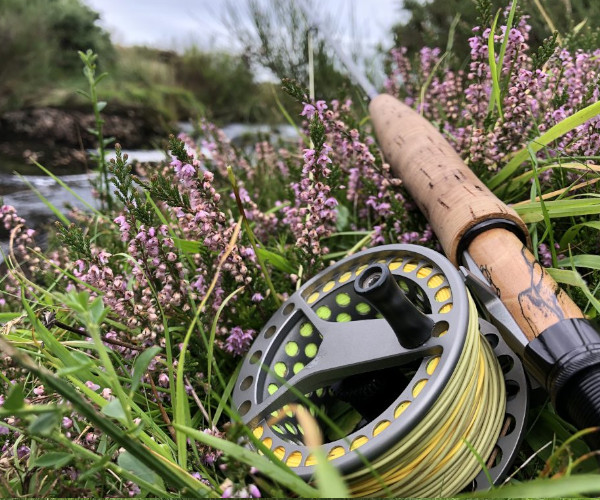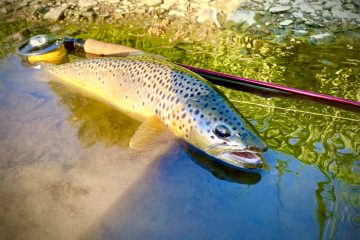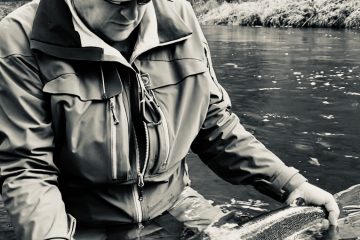It’s time to buy a new fly line. Your old one’s cracked and rough and ready for the bin. You’re on the internet looking for your next new line – where do you start? Here are a few things to think about.
Fly line profile
Fly line profile is for the most part what determines the way the line rolls out. If you choose a weight-forward line, its head is made up of a front taper, body and rear taper followed by the shooting line. A general-purpose WF trout line (e.g. a Rio Gold), has around 45-48ft of head length and the front taper would be in the ballpark of 5-6ft, body 23ft and total rear taper of 10-15ft.
Mass placement and casting
Another consideration is where the mass in the head is placed. On a Rio Gold it’s a forward bias which gives better overhead casting but isn’t quite so great at roll and spey casting. Put the mass at the rear of the body like a Rio Single Spey line and you have a line that spey casts and roll casts beautifully. And yes, you guessed it, not quite so great overhead casting with the mass at the rear of the body.
Both the Rio Gold and Rio Single Spey overhead, roll and spey cast, and can be used as a general-purpose line, but I’d favour the Rio Gold as a general-purpose trout line any day out of the two. With a short amount of line out the Rio Single Spey is not so easy to shoot line because of the large amount of mass towards the back of the head. With the Rio Gold, the mass in the head is right there and makes shooting line much easier on a short line.

Fly line taper length
If you shorten the front taper, the line will turnover more positively, which is great for sink tips and large flies. Lengthen the front taper and the line will turn over more delicately, but won’t want to turn over sink tips, heavy or big wind resistant flies. If you’ve ever cast a line without a leader on, it cracks and pops like a whip. The leader is basically an extension of the front taper within the fly line and reduces the energy as it travels down the taper.
For fishing on a river, a tapered leader of 9-12ft with 2-4ft of tippet is your norm for dry fly fishing. Try that set up with an indicator and two 3mm tungsten beaded nymphs and it can get a bit tricky – you might need to shorten the tapered leader by 3-4ft to increase the turnover energy because the load has increased.
Several companies offer nymph taper lines specifically for this purpose (although not to be confused with Euro nymph lines), with short and blunt front tapers, designed to carry more mass to turn those nymphs over at the end of the leader. A well set up leader on a Rio Gold will have no problem turning over 3 mm tungsten nymphs as long as it’s a 4# – below a 4# line it gets tricky.
Summary
In this modern age of fly fishing there are so many trout fly lines on the market, it’s enough to make your head spin. Just remember this – there is no magic bullet where fly lines are concerned – no matter what the advertising says.
In this article I’m just talking about lines we would use with a single-handed rod, fishing a dry fly, wets- or tungsten-weighted flies on the river for trout. If I were to delve into DT lines, Skagits, Scandi, chuck and duck, Mow tips and Versi tips it would be a very long article.
Understanding fly lines is part of your magical journey in fly fishing – it’s an ever-evolving and perfecting art. A good way to think about tapers on a fly line – the more perfect you make a fly line for a specific task, the less perfect that fly line is for general purpose use. A great caster who can generate high line speed with expert control can get away using a long fine front-tapered fly line with a lengthy leader. Lines such as a Rio Light Touch or LT, a Rio Grand fly line are much heavier and will benefit a less experienced caster with their shorter front taper helping to get that turnover of the leader.
Our choice of fly line
At the school we use Rio’s Mainstream (grand taper) and Avid Gold lines as our general-purpose fly lines on medium to large rivers. On our small streams we use Rio’s Creek line, which has a very short and compact head to load the rod with less fly line out of the tip of the rod. There are many great fly line brands out there and it’s great fun experimenting with different lines to see how they perform. This article is not meant to be an exhaustive resource of information on what line you should buy, but I hope it’s helped to explain some of the basics (we are in no way sponsored by Rio, we just like their lines).
If you want to know more about how we choose the most appropriate fly line for the environment we’re fishing in then please feel free to get in touch with us or join us on one of our fly fishing courses and we’ll show you how to get the best out of your equipment.

